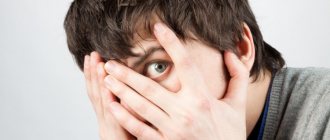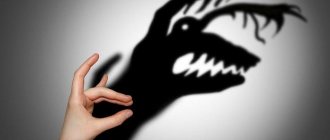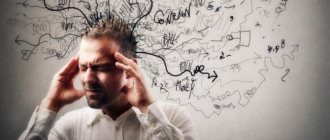Obsessions about causing harm to oneself, characteristic of this type of OCD
In some cases, a person will have intrusive thoughts about harming themselves, often as a result of trying to imagine different ways to avoid anxiety. A person is horrified by the thoughts and images that are born in his mind. One very important point to note here is that the fear of harming oneself is fundamentally different from actually engaging in behaviors that involve self-harm, such as cutting oneself. When a person is afraid that at some point he will commit suicide, these fears have nothing to do with suicidal thoughts, which can become a reality. If you have harm-related OCD, you may have unwanted, intrusive thoughts that you might lose control and do something to yourself. If there is a real tendency towards suicide, a person draws pictures of possible ways to settle accounts with life in his fantasies. Another important point to note here is that people who suffer from harm-related OCD are no more likely than the general population to experience aggression and violence, nor are they more likely to have harm-related OCD than the general population. causing harm does not indicate that such a person poses a danger to himself or others. The therapist needs to take all these points into account when assessing the client’s condition and analyzing the obsessions that torment him in order to identify his true intentions.
Reasons for absurd fears
Why did a reasonable and adequate person suddenly begin to draw colorful pictures of self-destruction and become terribly afraid of them?
This disorder is classified as a group of obsessive-compulsive disorders (OCD). Such fears can attack any person, even those who are not familiar with VSD, and they always imply some kind of projection of deep anxiety for life - one’s own or dear household members: husband, parent, child and even beloved cat. Psychologists emphasize that it is extremely rare for a person to be afraid of harming one of the strangers or work colleagues - after all, their life and health are not of such great value to us. But the fear of harming oneself and loved ones is precisely based on deep affection and love. We also passionately love and cherish ourselves, and coupled with the natural fear of death, such love often turns into a form of OCD. Especially if anxiety for life and health haunts you regularly, as happens with VSD.
Other reasons why this phobia manifests itself in dystonics:
- At one point in life, a person becomes too fixated on the negative, and internal anxiety crosses the critical line. With dystonia, patients tend to scroll through negative records in their heads. As a result, neuroses and phobias appear that project our subconscious fears;
- Psychological shocks experienced at school age. These could be quarrels between parents, as a result of which the child realized: he is unprotected, and anything can harm him. Violence, humiliation, attacks from classmates - all this also adds up to a creepy and harmonious picture of OCD. By the way, the VSD itself may be directly related to the childhood of its “chosen one”;
- Low self-esteem and constant nagging at oneself plant in the subconscious the thought “I’m a loser, I’m not perfect, it would be better if I didn’t exist.” Feeling guilty about himself, a person begins to defend himself against his own dislike with excessive self-care, pity and trepidation. The result is the development of neurosis, obsessive thoughts about the inadmissibility of self-destruction;
- Individual character traits, a tendency to dwell on grievances, anxieties, personal qualities, and shortcomings. Some people literally cannot live without self-criticism and soul-searching. Moreover, if one phobia is miraculously realized and “released,” another immediately appears. If yesterday a person considers himself a heart patient and has cardioneurosis, then tomorrow this same person will already be obsessed with the fear of harming himself;
Obsessive-compulsive fears
This group contains phobias based on an irrational fear of causing harm to oneself or others in any specific way:
- fear of pollution (mysophobia);
- fear of suicide;
- fear of killing or harming the health of your loved ones;
- fear of sharp objects (aichmophobia).
With these disorders, the patient periodically experiences obsessive ideas, often accompanied by obsessive stereotypical actions and causing intense, inexplicable anxiety. Almost always, patients try to take control and resist their thoughts and actions, but their attempts are unsuccessful. Patients retain a critical attitude towards their obsessions; they recognize their behavior as illogical, senseless, ineffective and often disgusting. However, trying to resist your obsessive thoughts and actions only increases anxiety and anxiety.
People suffering from these disorders often feel ashamed of their exaggerated and irrational fears and try to hide their “oddities” from others. As a result of forced long-term masking of symptoms, the individual experiences strong emotional experiences and is in a state of constant stress, which seriously interferes with the establishment of social contacts and the performance of professional activities.
In clinical psychiatry, the most frequently recorded cases are mysophobia - obsessive states with a dominant idea of pollution. Some common obsessive fears include:
- fear of contamination by earth, dust, “sewage” (urine, feces);
- fear of toxic substances entering the body (for example: household chemicals, fertilizers, toxic waste);
- fear of small foreign bodies (for example: glass fragments, needle fragments, animal hair, human hair);
- fear of penetration of germs and bacteria.
In most cases, the fear of pollution is limited, preclinical in nature, characteristic of pedantic individuals and manifests itself in excessive attention to personal hygiene and the sanitary condition of the home. Thus, frequent washing and “ironing” of linen, repeated water treatments, excessive heat treatment of food, and thorough cleaning of the apartment are perceived by others as personal habits of a person. Although excessive cleanliness and disgust that have reached accentuation make changes to an individual’s daily routine, they generally do not affect a person’s lifestyle.
Having taken a pathological course, habits develop into severe obsessions: phobias. In these cases, the patients’ behavior gradually changes, protective rituals are invented and become more complicated. This way, the mysophobe will avoid possible sources of pollution and will not touch, in his opinion, “unclean” things. A person suffering from this disorder diligently handles personal belongings, often resorting to repeated washing and even boiling clothes. He develops and follows a certain sequence in the use of household chemicals, has sets of sponges, napkins and towels, and tries by all means to maintain “sterility” in the home.
When leaving the apartment, the patient carries out a number of protective measures, for example, going outside in things that cover the body as much as possible, or making sure to wear a gauze bandage on the face. In the severe stage of mysophobia, the patient, in order to avoid contamination, does not leave the confines of his own home and avoids contact even with family members.
In this group of anxiety-phobic disorders, as a rule, one-time or episodic manifestations do not occur. The disease has the property of “chronification,” that is, an increase in anxiety symptoms over time. In some patients, the disorder occurs cyclically, while another group of patients experiences constant painful manifestations of obsessive fear.
A quarter of a century ago, treatment of the disease was not effective enough, primarily due to the lack of a basis for diagnosing the disorder. With the development of psychotherapeutic techniques and the use of modern medications in treatment, in most cases it is possible to completely cure obsessive-compulsive disorders.
SUBSCRIBE TO THE VKontakte GROUP dedicated to anxiety disorders: phobias, fears, obsessive thoughts, VSD, neurosis.
How are fears useful?
Fear for a person initially performs a useful function of protection against a possible threat to his existence. There are several examples of the benefits of this or that fear:
Fear of pain
Fear of pain (or algophobia) is beneficial when it prompts a person to think better about the consequences of his actions.
Fear of physical pain can save human life by acting as a “brake signal” before possible danger, which includes the release of adrenaline into the blood and, as a result, the active mobilization of all the main resources of the body, which increases its physical endurance. Many cases have been described around the world where, in a state of fear, people performed actions beyond their normal capabilities.
Interesting! The theory of the German psychoanalyst Riemann states: fear of pain is a useful emotion, passing through which develops and improves a person.
Fear of water, fire and animals
Fear of water, or hydrophobia, in a person who is a poor swimmer is an absolutely normal phenomenon, the benefit of which lies in preserving his life. Likewise, fear of fire (pyrophobia) and other elements, as well as animal attacks, are usually based on specific negative experiences. However, in origin they are the most ancient, biological fears: the scales are tipped towards benefit or harm, depending on the presence of a neurotic component, which, outside the norm, transfers the emotional alarm signal from the constructive task of self-preservation to the destructive level of destruction of the psyche.
Fear of the dark
Research on the benefits and harms of fear of the dark has shown that it tends to manifest itself in more than 90% of people: the difference lies only in the degree of its severity. Originating in early childhood, it can become fixed and appear regularly in the consciousness of an adult.
The benefits of fear of the dark, in addition to its direct protective function, are indirectly related to creativity, since the emotion tends to actively manifest itself in people with a rich imagination. The useful energy resource of this fear can be used to develop a person’s creative skills.
Fear of loneliness
Fear of loneliness, or, in its painful manifestation, monophobia, is harmful to social isolation, but normally the benefits of such fear are also hidden in the potential of the person himself. Psychological studies have shown that monophobes are often open and friendly people with a fairly large circle of friends and acquaintances. They tend to value friendships and relationships highly, but are afraid of losing it all.
Fear of death
This is a natural feeling for everyone, which, however, at the level of thanatophobia deprives a person of strength. Mastering the energy potential behind this fear opens the way to a transcendental level of revaluation of your life. Questions of “life and death” help people build their moral guidelines and principles. For example, the fear of sudden death helps a person realize the value of every moment he lives and motivates him to enjoy life in all its manifestations.
We recommend reading: Soda baths: benefits and harms, recipes, reviews
This is the basis for the beneficial effect of the technique of getting rid of the obsession with the idea of death: “die in advance”: imagine that the inevitable has already happened. And think about what causes regret most in such a fatal scenario: unfinished business, unsaid words on time, unfulfilled desires. Everything that such an analysis reveals must begin to be implemented.
Fear of heights
Fear of heights brings undoubted benefits to a person’s safety, protecting him, for example, from the risks of such popular entertainments as bungee jumping, bungee jumping and rope jumping. In its healthy manifestation, fear will force a person to evaluate his strengths and possible harm from the adverse effects of such adrenaline stimulants. However, if a person experiences panic, even looking out of the window of a multi-story building, this will be a sign of the presence of acrophobia, which requires long-term therapy.
The same is true with similar fears: for example, fear of closed or open space, which normally have undoubted benefits for human life, but in the form of an irrational manifestation of such emotions (claustrophobia and agoraphobia, respectively) can cause serious mental damage.
Fear of harming your child.
Hello, Oksana.
Firstly, I want to reassure you, fears for your baby indicate your excessive responsibility for him and your desire to protect him from any threat. Your fear for him is so exaggerated and does not contain any real confirmation that, without finding a real threat to his (fear) embodiment, you “constructed” the situation by finding suitable material in a completely different reality (a newspaper article), which has no nothing to do with you.
Secondly, let's touch on your mental disorders. In this format, we will not go deeper in search of the reasons for your violations due to lack of information. Obviously, they have their roots in your childhood, the analysis of which requires a lot of time and effort. Here I will provide you with information on how it works and describe some techniques so that you can alleviate your condition on your own. A person perceives reality through certain patterns formed throughout the person's experience. Otherwise, reality would be simply a stream of meaningless information for him. Our brain imposes a diagram on the situation, gives it a certain interpretation, based on the experience of each person and the significance of this situation for him. Therefore, different people can interpret the same situation differently. If the scheme corresponds to reality and leads to an adequate human reaction, it is called adaptive. However, under the influence of a stressful situation, the scheme of perception of reality can be distorted. The scheme becomes maladaptive, and the perception of reality is disrupted. (For example, a “negative filter” is installed, which allows only facts that we interpret as negative; “positive” facts remain outside the filter. This leads to depression). After activation of maladaptive schemes, a person risks losing control over reality. Fortunately, in your situation, you are quite capable of analyzing your condition, which means, under certain conditions, you will be able to control it.
Third. Let's return to your situation in which you are afraid of harming your child. This thought gives rise to fear and horror in you. It is the thought that provokes your feelings. But this is just your thought, not supported by any facts. Don't be afraid of her.
Every time it occurs, go to your child, hug him, smile at him and tell him how much you love him. This will not be a lie to the baby. Your judgment is contrasting (opposite), it is not caused by hatred, but by love and care for your baby.
Another way to get rid of a negative thought is to write it on a piece of paper, read it and tear up the sheet. Take a new piece of paper and write how much you love your child.
Third way. Take a small piece of ¼ notebook paper or a piece of paper for notes. On one side, write your negative thought “I can harm my child,” on the other side of the sheet, write the opposite judgment and support it with facts. For example: “I would never harm my child. I love him, I care about him, I protect him, I may be wrong about something, but it’s safe for my child.”
And the last method that I will give you in this answer is called “Advice to a friend” (in our case, a friend). You probably already guessed that you need to imagine or imagine a woman who came to you for advice with a problem (like yours). What advice would you give her? Calmly think about how to help her within an hour, and maybe during the day. Write down your suggestions. When you have enough ideas, start implementing your plans.
These techniques can be used for any negative thoughts that make your mood worse or cause you to experience strong negative feelings (fear, anxiety, etc.). Remember that your emotions depend primarily on your thoughts. And then your emotions provoke a certain behavior of yours. Work with your thoughts, and gradually you will feel better.
Very often women who strive to be ideal mothers face a problem similar to yours. The concept of an “ideal mother” is very vague, and often women rely on a fictitious, abstract image. In fact, the concept of an “ideal mother” exists, and it is not an abstract concept at all. If a child, being next to you, smiles, laughs and looks happy, then you are an ideal mother.
Rate the psychologist's answer:
Rating 4.50 (2 Votes)
What can you do yourself?
So, there are several psychological techniques for dealing with obsessive thoughts.
- “Turn off the switch.” The task here is to present your fears as vividly and realistically as your courage allows. But the catch is that the pictures must be shaped like a switch. Introduced - and turn it off.
- "Let's play a play." Stand in front of a mirror and imagine yourself as an actor rehearsing an important speech. You need to convince the audience that you are an absolutely brave person and have never been afraid of harming yourself in your life. This is funny and absurd, but you are not like that.
- "Inhale/exhale." We take a deep breath and imagine that courage and self-confidence are spreading throughout our body. Are there still any doubts there? They need to be exhaled - slowly and efficiently.
In any case, it is important to understand that obsessive thoughts of harming yourself or loved ones are just a phobia, and this does not threaten you with actually starting to cause harm.
And, of course, if you want to find out the true cause of this phobia, seek help from a psychologist. Sometimes it is enough to see the problem of the past and change your attitude towards it, and you will not have to engage in various sophisticated techniques for survival, being locked in the cage of your thoughts.
Do these scary thoughts come true?
The nature of obsessive thoughts is very curious and ambiguous. If a person treats sore tonsils or acne, he will always be able to observe and feel the result. Disappeared pimples will not grow back only because a person is terrified of their appearance. In the case of thoughts, everything is more complicated. Here we are actually dealing with “ghosts” that visit our heads, sometimes completely disregarding our desires and fears.
The more we resist a certain thought, the stickier it becomes and the harsher it treats us. Trying not to think, for example, about lemon, we ourselves bring this healthy citrus into our heads. We see its color and can even taste it - this is how our brain works. We believe in ourselves. This is why thoughts have such an effect on our emotions. We love to remember pleasant moments and replay them in our heads. But as soon as our head “breaks” and begins to reproduce terrible scenes where we kill ourselves, cut ourselves, beat or strangle ourselves, in a panic we set ourselves a taboo on such pictures.
“A normal person should not have such thoughts,” we tell ourselves. And thus we feed our phobia with fear and resistance. The more a person tries to forcefully block certain thoughts, the more persistently they creep into his head. But if you look at the situation objectively, there are all sorts of pictures that exist in human minds, and the only place where they can be embodied is the artist’s canvas. OCD in any form is absolutely not associated with madness, as VSD people think. And the fear of harming yourself will remain just fear. As long as a person is afraid of going crazy and realizes the absurdity of some things, no one can call him crazy.
And, of course, there is good news. Self-destruction phobia is a reversible condition, which means it is completely correctable.










